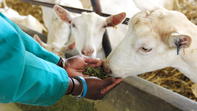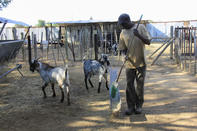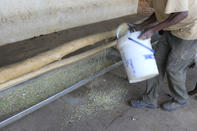Goats are popular farming animals because they are predominantly browsers and can be used in shrub and bushveld farming areas together with grazers like cattle.

Being browsers (eating leaves from shrubs) they are therefore not competing with cattle for food. In addition, the browsing habits of goats help to combat bush encroachment in Savannah and bushveld areas, but may also cause overgrazing.
Most goats kept in villages (such as indigenous goats) are generally not fed any grain but forage for food, therefore, their daily milk yield is usually quite low. To ensure good milk production, they would need extra nutrients and will respond well to good care and supplement feeding.
Feeding of milk goats, meat goats and goats bred for fibre (mohair or cashmere) will require specific rations based on their production stage and condition. An animal nutritionist or feed company can help to formulate a balanced feeding plan for goats.
Feeding Habits of Goats

Goats are sensitive animals with strange feeding habits. They do not eat feed that is dirty or foul-smelling and dislike wet, old or trampled fodder. Goat feed must be clean and fresh and should always be put in a trough. Keep troughs clean by removing any leftovers.
When feeding hay, put it in hay-racks or hang the feed in bundles from of a tree or a peg in the wall. Goats are ruminants and would rather eat leguminous fodders like lucerne and cowpeas (high in protein), than sorghum, maize, silage or straw. Buy the best quality feed that you can afford and store it away from the sun and rain.
Collect hay in the growing season and store this for times of food shortage in the dry season. Cereal crop residues and grass fodder should be chopped before feeding and grains can be crushed. Mix feed very well to prevent goats picking out just the tasty bits.
To provide feed fresh; only feed for one day's feeding should be mixed. Do not let the feed become old or mouldy. Any changes in the feeding of goats should be made gradually, over at least a week.
Energy and Protein Needs for Goats

Carbohydrates and fats both provide energy. Energy is required for growth, fertility, reproduction and resistance to diseases and parasites. Goats also require protein.
Protein is the primary building block of every cell in the bodies of all animals and is essential for growth, disease resistance, reproduction and lactation (production of milk). One of the most important food categories for all goats is energy - expressed as TDN = total digestible nutrients.
The total amount of feed a goat will eat each day is measured in terms of ‘Dry Matter Intake' (DMI). The amount of dry matter eaten depends on the size of the goat, its activity and productivity. Maximum DMI will only be achieved if there is enough food and it tastes good. Adding a sufficient amount of greens in your goat's regular diet is a must, whether you are producing goat meat or goat milk.
Dairy goats especially require greens more than the meat goats, so ensure a good supply of greens for your goats. If pasture is not available, plant various types of hybrid grass and small trees on a separate piece of land. Concentrate feeds that are high in energy are maize, barley, brewers' grains and cottonseed oil cake meal. (Brewers grains are the solid residues left after the production of beer.
Though barley is the main grain used for brewing, wheat, maize, rice, sorghum and millet are also used.) Feeds for goats that are high in protein include fishmeal, soya bean meal, cottonseed oil cake meal as well as brewers' grains.
Please note: Information is for educational and informational purposes only and may not be construed as feeding or nutritional advice. For more information on feeding your goats contact your animal health technician, veterinarian or animal feed supplier.
By Marinda Louw